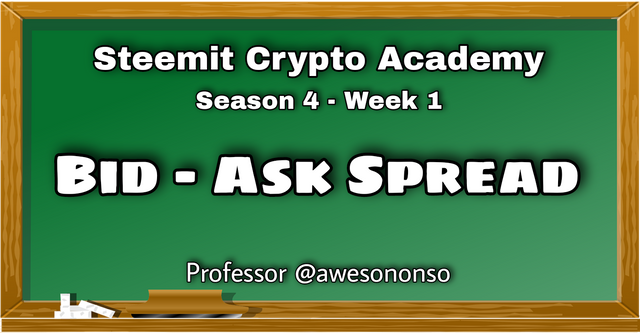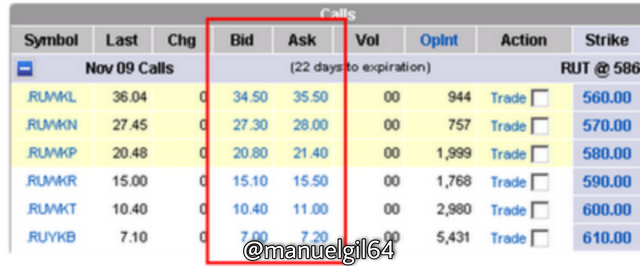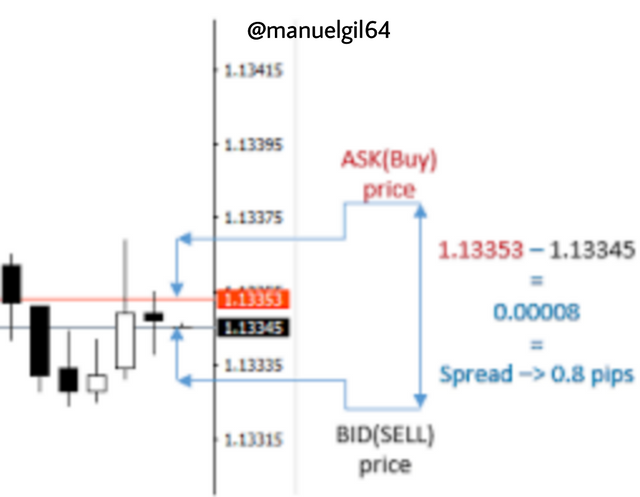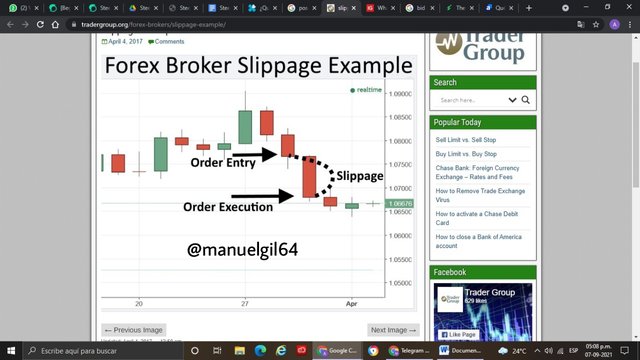Steemit Crypto Academy Season 4 - Week 1 || Bid-Ask Spread by @awesononso
"The fundamental law of investing is the uncertainty of the future."
Peter Bernstein

Image edited with PicsArt
Steemit Crypto Academy Season 4 - Week 1 || Bid-Ask Spread by @awesononso
One of the concepts most commonly used by traders, whether in the stock, FOREX or crypto-asset markets, is the Bid-Ask Spread, which reflects to a large extent, the liquidity in these markets and the cost of the operations performed, as we will have the opportunity to explore in greater depth in the following post.

What is the Bid-Ask Spread?

Image edited with PicsArt
The supply-demand differential, known as Spread, is the difference between how much it costs to buy a share and how much you would receive to sell.
By definition, the Bid price is the selling price being the highest which the market is willing to buy a share, while, the Ask price (purchase price) is the lowest point the market is willing to sell a share.

Image edited with PicsArt
That being said, when buying an asset it is necessary to look at the Ask (Demand) price, as it will be the maximum price that we will pay for such an asset. Instead, if you want to sell, the Bid price (Supply) will be our focus as the price the buyer will pay us for selling our asset.
Thus, when is talking about Spread, it is known as the difference between the best price on offer and the best price on demand that an asset is receiving. If, for example, the maximum bid price of a share is 100 and the minimum ask price is 101, the spread is said to be 1. However, this price difference is usually maintained by a broker, so traders prefer to see low spreads as it means they are saving money on transaction costs.

Image edited with PicsArt
However, one of the most influential factors in the size of the Spread is the number of merchants available in the market, since when the number of stocks and merchants are limited it can drastically increase the size of the same, as fewer participants place limited orders to buy a value, so that less offer prices are generated, or as fewer sellers, these place limited orders to sell, so that sellers may want a price while buyers want a completely different price.
On the other hand, the volatility of the asset is considered as a major factor in the determination of the spread as it contributes to the increase in the value of the spread.

Why is the Bid-Ask Spread important in a market?
Although we do not know, the spread is present in almost all the transactions that we make every day, when we are going to buy or sell some product we find that there is a difference between the bid price to which we can sell and the ask price to which we can buy.
The impact of spread on the cost of operations is also noted. Therefore, the importance of the spread in the market lies in the fact that the larger the difference between the purchase price and the sale price, the higher the cost of the share, the lower the liquidity and in turn, the higher the risk.
Similarly, when the spread between the two prices is small, it will produce lower risk and greater liquidity, therefore, the market for that product will be more efficient as there are less frictions.

Image edited with PicsArt
It is also possible to see the impact of the purchase and sale spread on the market according to the relationship between the value of the spread and the price of the asset quotation by means of an example:
If you have a product X that cost $100, and a product Y that cost $0,10. And the product X sells its stock for $100.01, the spread will represent a difference of 0.01%. Otherwise, if the product Y sells its stock for $0.11 (with the same amount of spread as X), the spread will represent a 10% difference. Therefore, we can say that the lower the price of the product, the greater the impact of the spread percentage.

Image edited with PicsArt
Now that we know this, we can refer to the supply and demand spread as the natural measure of the liquidity of the market, since the lower the value resulting from the spread, the higher the level of liquidity of the market where it operates and therefore, greater stability in the asset.
Therefore, if you want to compare the level of liquidity between two assets you only need to calculate the margin of spread.
✅ If Crypto X has a Bid price of $5 and an Ask price of $5.20
So, if you have a Bid price of a Crypto X of $5 and the Ask price is $5.2, you can calculate the bid and demand margin as follows:
The Bid Price = $ 5
The Ask Price = $ 5.2
Bid - Ask Spread = Ask Price - Bid Price = $ 5,2 - $ 5 = $ 0,2
While the Spread in percentage is calculated as follows:
Spread (%) = (margin / selling price) x 100 = (0,2 / 5,2) x 100 = 3,84 %
✅ If Crypto Y has a bid price of $8.40 and an ask price of $8.80
Instead, if you have a Crypto Y with a bid price of $8,4 and a sale price of $8,8, you calculate the bid and demand spread, and the margin percentage as in the case described above:
The Bid Price = $8,4
The Ask Price = $8,8
Bid - Ask Spread = $ 8,8 - $ 8,4 = $ 0,4
% Spread = (0,4 / 8,8) x 100 = 4,54 %
✅ In one statement, which of the assets above has the higher liquidity and why?
Now, knowing the values of both differentials I can affirm that Crypto X has more liquidity than Crypto Y just by observing that the spread of the first is less.
This in turn assures us that there are more participants in the Crypto X market, therefore, as long as there is more trading volume, there will be more liquidity and supply and demand margins will be narrower, so the purchase prices will be so similar that the spread will have little impact on the transaction. So a liquid asset offers the facility to buy or sell at the desired price.

What is Slippage?
Among the markets with less liquidity is that of cryptos because they are so volatile assets do not have the facility to maintain a stable value. Thanks to this, the purchase and sale price can be affected in a matter of seconds and causes slippage, which is defined as the price difference that can occur between the time a trading order is placed and its actual execution in the market.
To understand it in a more explanatory way, suppose as an example that I try to buy a stock at $10, but when I click to buy, the offer jumps and they run it at $10,10. The extra 10 cents I paid would be the sliding fee, so it subtracts the price you expect to pay for a share less the price you end up paying. Sometimes, this factor occurs because each price and volume of trade in a purchase order must coincide with sales orders of equal price and volume, which causes traders to enter or exit a trade at a price that is higher or lower than they wanted.
Now, can the slippage be beneficial for the trader? Absolutely, the price difference can be either positive or negative depending on the direction of the price movement, therefore it can work in favor of the trader, the difference incurred during the execution of the order can be made in the opposite direction to the position, which adds profit points or reduces loss.
For example, if we try to sell a stock at $5,50 but offers are still rising, we might get a higher offer, which increases your reward and is seen on the chart as follows:

Image edited with PicsArt
On the other hand, it cannot be ignored that the slip at the time of trading has a general definition of risk for the trader since the final result remains unknown before the execution (negative or positive), because in the worst case: you may want to sell an asset at a certain price, for example at $15, and you will not develop the expected offers, so the transaction runs at $14,5.
So the negative slip would be: $15 - $14,5 = $0,5
For this reason, it will generally be attempted to avoid or reduce it as much as possible through strategies and tools that facilitate the trader’s operation.

Image edited with PicsArt

This is my Homework Post for Steemit Crypto Academy Season 4 Week 1 || Bid-Ask Spread by Professor @awesononso


twitter-promotion
#promo-steem
Hello @manuelgil64,
Thank you for taking interest in this class. Your grades are as follows:
Feedback and Suggestions
You should try to be clearer in your explanations. A clear explanation improves the overall presentations.
There are a couple of points still missing on the topic and others that need to be revisited.
Thanks again as we anticipate your participation in the next class.
Congratulations, your post has been upvoted by @dsc-r2cornell, which is the curating account for @R2cornell's Discord Community.
Enhorabuena, su "post" ha sido "up-voted" por @dsc-r2cornell, que es la "cuenta curating" de la Comunidad de la Discordia de @R2cornell.